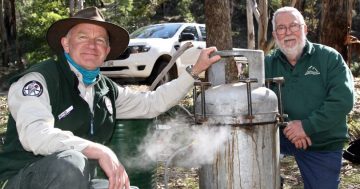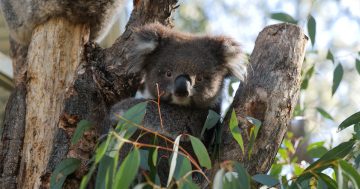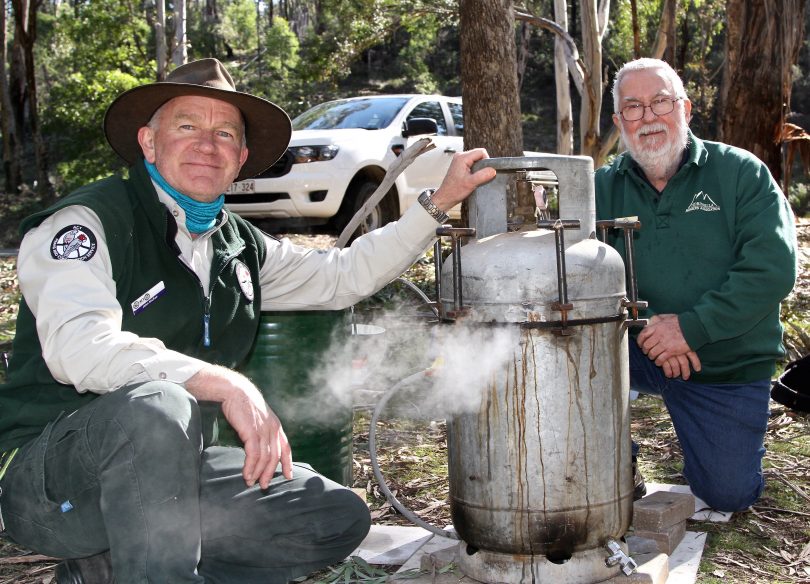
ACT Parks and Conservation Tidbinbilla area manager John McRae with Tidbinbilla Pioneers Association vice-president Geoff Puleston. Photo: Michael Weaver
Geoff Puleston hasn’t had to worry about hand sanitiser this year – he has his own constant supply courtesy of eucalyptus leaves at Tidbinbilla.
To sanitise, simply rub your hands in the steam released from the distillation of oil from the leaves.
Making eucalyptus oil is an age-old process that Geoff is keeping alive in the same location where a few brave migrants from Czechoslovakia began extracting the precious oil in the early 1940s.
Indigenous Australians first used eucalyptus leaves to help ward off colds, while there are stories of how the first residents at Tidbinbilla survived on the smell of an oily eucalyptus tree.
“Nobody ever got the flu,” Geoff tells Region Media.
“One of the landowners about two or three kilometres up the hill had an issue with fleas. Word got around and soon [Czechoslovakian migrant] Jan Jandura-Pucek knocked on their door with a container of eucalyptus oil. It fixed their flea problem, so they gave him bread and butter puddings and other food, in the strong spirit of sharing resources that were a
a hallmark of the Tidbinbilla farming community of the day.”
Jan Jandura-Pucek, Steve Lajcin and Martin Tekel were the pioneers of the fledgling industry in the area that paid the equivalent of $2600 for a drum. Each man could earn more than 14 pounds per week from the oil, considerably more than the 5 pounds paid for work as a farmhand.
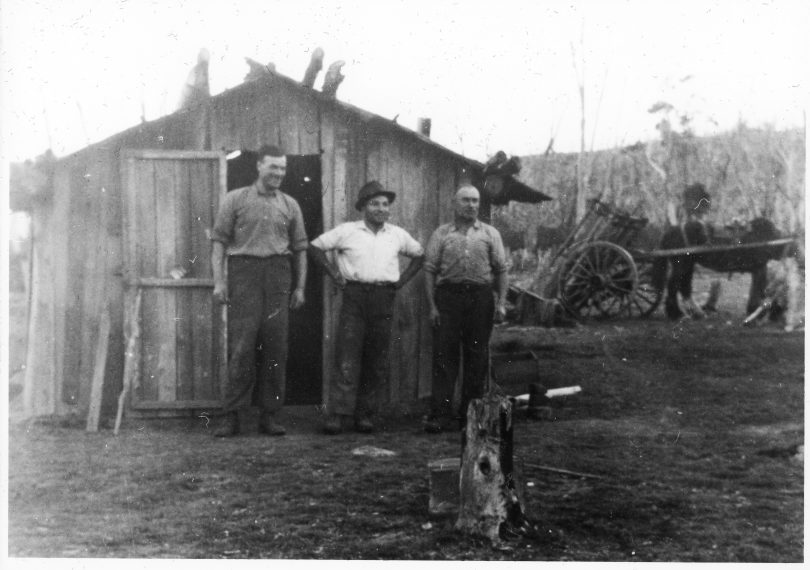
Steve Lajcin, Jan Jandura-Pucek and Martin Tekel outside a fodder shed at Black Flats (note the stripped eucalyptus trees in the background). Photo: Supplied.
Eucalyptus distilleries were popular after World War II as many producers were able to avoid paying royalties to the Commonwealth by working on free-hold land such as Black Flats at Tidbinbilla. A second distillery at nearby Nil Desperandum was regulated somewhat with the men having to take additional precautions to prevent fires.
“They were very well respected by the locals in what was a hard-working farming community. It was no-nonsense and fairly austere and these three men worked harder than anybody – they had to scrounge for materials that weren’t readily available – so they were respected for that reason, but also because they got on really well with the community,” says Geoff, the vice-president of the Tidbinbilla Pioneers Association.
In 1949, Jandura-Pucek was also the first migrant to receive Australian citizenship.

Eucalyptus still at Nil Desperandum, circa 1948. Photo: Supplied.
The men lived at Black Flats at Tidbinbilla but worked the two distilleries at Black Flats and Nil Desperandum, where they also set up camp. They rotated between the two sites, decanting one 44-gallon drum every two to three weeks. They would cut eucalyptus leaves five days a week, distil on Saturday, which left Sunday for a day of rest.
After the local industry dried up when the Czechs moved on to other ventures and many other European immigrant workers left for the lucrative Snowy Mountains Hydro project, all that was left were the empty tanks.
“Orders were given to clear any remnants of the land being used for anything that wasn’t deemed natural, so a lot of heritage was lost,” Geoff says. “They found an old eucalyptus tank in the hill near Black Flat, though, so someone obviously didn’t want to see it destroyed.”
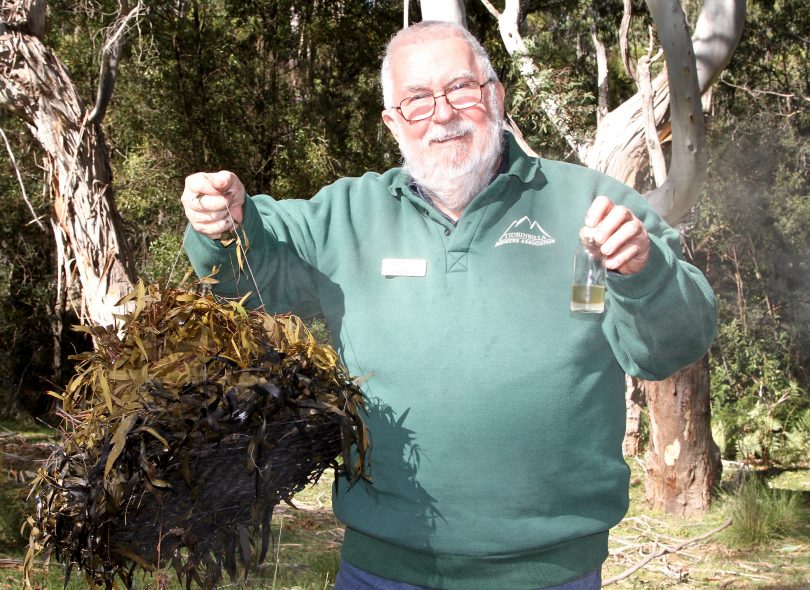
Geoff Puleston shows the oil produced from a small batch of eucalyptus leaves. Photo: Michael Weaver.
With the help of ACT Parks and Conservation, the heritage of Tidbinbilla’s eucalyptus distilleries is being renewed thanks to an ACT Heritage Grant helping to fund a static display that will replicate the original distillery at Black Flats.
Geoff, who sets up his miniature eucalyptus still a few times a year, is hoping the display will be built within the next month.
“We’ve been pleasantly surprised by the public interest in the process, so once the static display is set up, we’ll be able to show people a scaled-down version of the distillery that operated in the 1940s and 50s,” he says.
Geoff and Tidbinbilla area manager with ACT Parks and Conservation Service John McRae are buoyed by the prospects that the heritage of the area present, with groups such as the Tidbinbilla Pioneers Association doing their utmost to preserve its rich history.
READ ALSO: Tidbinbilla’s koalas finally return home, with one or two new arrivals
For Geoff, the beauty lies in the leaves of the eucalyptus trees.
“It’s being able to touch on a historical process, even though it’s a modern-day process now,” he says. “I’ve got a great interest in history and being able to interpret the process to people when they come to visit Tidbinbilla.
“I also love to tell the stories, and there are plenty.”
Read more about the history of eucalyptus distilling in Australia, the process and industry in the Queanbeyan district after World War II.











